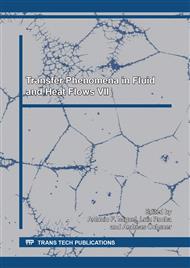[1]
N.R. Edmunds, Observations on the Mechanism of Solvent-Additive SAGD Processes,, SPE Paper 165419 presented at the SPE Heavy Oil Conference Canada held in Calgary, Alberta, Canada, 11-13 June, (2013).
Google Scholar
[2]
J.E. Nenniger and S.G. Dunn, How Fast is Solvent Based Gravity Drainage,, PETSOC-2008-139, Canadian International Petroleum Conference, 17-19, Calgary, Alberta, Petroleum Society of Canada (2008).
DOI: 10.2118/2008-139
Google Scholar
[3]
M. Ardali, M. Barrufet, D. Mamora, and F. Qiu, A Critical Review of Hybrid Steam/Solvent Processes for the Recovery of Heavy Oil and Bitumen,. Society of Petroleum Engineers.
DOI: 10.2118/159257-ms
Google Scholar
[4]
https://business.financialpost.com/commodities/energy/imperial-oil-seeks-approval-for-new-2-billion-oilsands-project-near-cold-lake.
Google Scholar
[5]
https://www.cbc.ca/news/canada/calgary/nsolv-pilot-project-success-1.4012709.
Google Scholar
[6]
http://www.pembina.org/blog/using-solvents-oilsands.
Google Scholar
[7]
https://www.sdtc.ca/en/portfolio/projects/best-bitumen-extraction-solvent-technology-field-pilot-plant.
Google Scholar
[8]
F. Ahmadloo, K. Asghari, A.,Henni, and N. Freitag, N. P. Interplay of Capillarity, Drainage Height, and Aqueous Phase Saturation on Mass Transfer Rate of Solvent Vapor into Heavy Oil,, Society of Petroleum Engineers.
DOI: 10.2118/148682-ms
Google Scholar
[9]
V. Mohan, P. Neogi and B. Bai. Concentration Dependent Diffusivities of Model Solvents in Heavy Oil.,, Diffusion-fundamentals.org. 27. 1-27, (2017).
Google Scholar
[10]
X. Jia, F. Zeng, and Y. Gu, Semi-Analytical Solutions to One-dimensional Advection-Diffusion Equations with variable Diffusion Coefficient and Variable Flow Velocity,, Applied Mathematics and Computation. 221. 268-281. 10.1016/j.amc.2013.06.052, (2013).
DOI: 10.1016/j.amc.2013.06.052
Google Scholar
[11]
Q. Yuan, X. Zhou, F. Zeng, K. D. Knorr, and M. Imran, Effects of Concentration-Dependent Diffusion on Mass Transfer and Frontal Instability in Solvent-Based Processes,, Society of Petroleum Engineers.
DOI: 10.2118/184994-ms
Google Scholar
[12]
Q. Yuan, S. Yao, X. Zhou, F.Zeng, K. D. Knorr and M. Imran, Miscible Displacements with Concentration-Dependent Diffusion and Velocity-Induced Dispersion in Porous Media,, Journal of Petroleum Science and Engineering, 10.1016/j.petrol.2017.09.030, 159, (344-359), (2017).
DOI: 10.1016/j.petrol.2017.09.030
Google Scholar
[13]
H. Abukhalifeh, A. Lohi, and S.R. Upreti, A Novel Technique to Determine Concentration-Dependent Solvent Dispersion in Vapex,, Energies, 2(4), 851-872.
DOI: 10.3390/en20400851
Google Scholar
[14]
S. K. Das, and R.M. Butler, Diffusion Coefficients of Propane and Butane in Peace River Bitumen,, The Canadian Journal of Chemical Engineering. 74. 985 - 992. 10.1002/cjce.5450740623 (1996).
DOI: 10.1002/cjce.5450740623
Google Scholar
[15]
X. Zhang and J. M. Shaw, Liquid-phase Mutual Diffusion Coefficients for Heavy Oil + Light Hydrocarbon Mixtures,, Petroleum Science and Technology, 25:6, 773-790.
DOI: 10.1080/10916460500411796
Google Scholar
[16]
S. Lorimer, R. Boehnke, and B. Meza, Mass Transfer Behaviour in Hybrid Solvent Oil Recovery Processes,, Defect and Diffusion Forum, Vol. 367, pp.77-85, 20160.4028/www.scientific.net/DDF.367.77, (2016).
DOI: 10.4028/www.scientific.net/ddf.367.77
Google Scholar
[17]
S. Lorimer, S and C. Smithaniuk, Nonlinear Behaviour of Mass Transfer Mechanisms in Solvent Oil Recovery,, Defect and Diffusion Forum. ISSN: 1662-9507, Vol. 379, pp.181-188.
DOI: 10.4028/www.scientific.net/ddf.379.181
Google Scholar
[18]
L.A. James, Mass Transfer Mechanisms during the Solvent Recovery of Heavy Oil,, Ph.D. Thesis, University of Waterloo, Waterloo, ON, Canada, (2009).
Google Scholar
[19]
E.Z. Evulukwu, Experimental Investigation of Concentration Dependent Non-ideal Diffusion in Hydrocarbon Systems,, Masters Thesis, Memorial University of Newfoundland, (2015).
Google Scholar
[20]
M. Sabeti, M. R. Ehsani, M. Nikookar, A. H. Mohammadi, Estimation of effect of diffusion and dispersion parameters on VAPEX process,, Journal of Petroleum Science and Engineering, Vol. 132, 53-64, 10.1016/j.petrol.2015.04.031, (2015).
DOI: 10.1016/j.petrol.2015.04.031
Google Scholar
[21]
Q. Wang, X. Jia, and Z. Chen, Modelling of Dynamic Mass Transfer in a Vapour Extraction Heavy Oil Recovery Process,, Can. J. Chem. Eng., 95: 1171–1180.
DOI: 10.1002/cjce.22743
Google Scholar
[22]
A. Sharifi Haddad, S.H. Hejazi, and I.D. Gates, Modeling Solvent Enhanced Gravity Drainage from a Single Matrix Block in Fractured Oil Reservoirs,, Journal of Petroleum Science and Engineering, 152, 555–563.
DOI: 10.1016/j.petrol.2017.01.043
Google Scholar
[23]
F.J. Roman and S.H. Hejazi, Estimation of Concentration‐Dependent Diffusion Coefficients of Gases in Heavy Oils/bitumen Using Experimental Pressure‐Decay Data,, Can. J. Chem. Eng., 94: 2407-2416.
DOI: 10.1002/cjce.22606
Google Scholar
[24]
S. P. Neuman, Universal Scaling of Hydraulic Conductivities in Geological Media,, Water Resour. Res., 26(8), 1749–1758, (1990).
DOI: 10.1029/wr026i008p01749
Google Scholar
[25]
D. Cuthiell and N. Edmunds, Thoughts on Simulating the Vapex Process,, Thoughts on Simulating the VAPEX Process. Society of Petroleum Engineers.
DOI: 10.2118/158499-ms
Google Scholar


